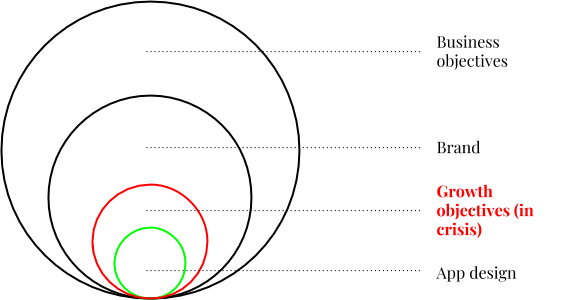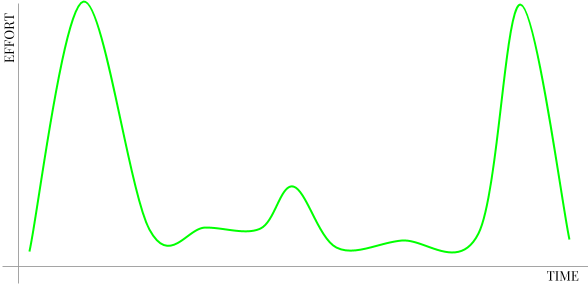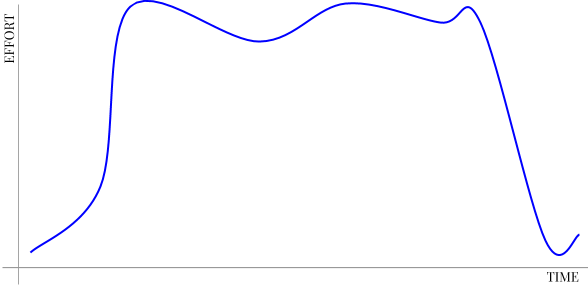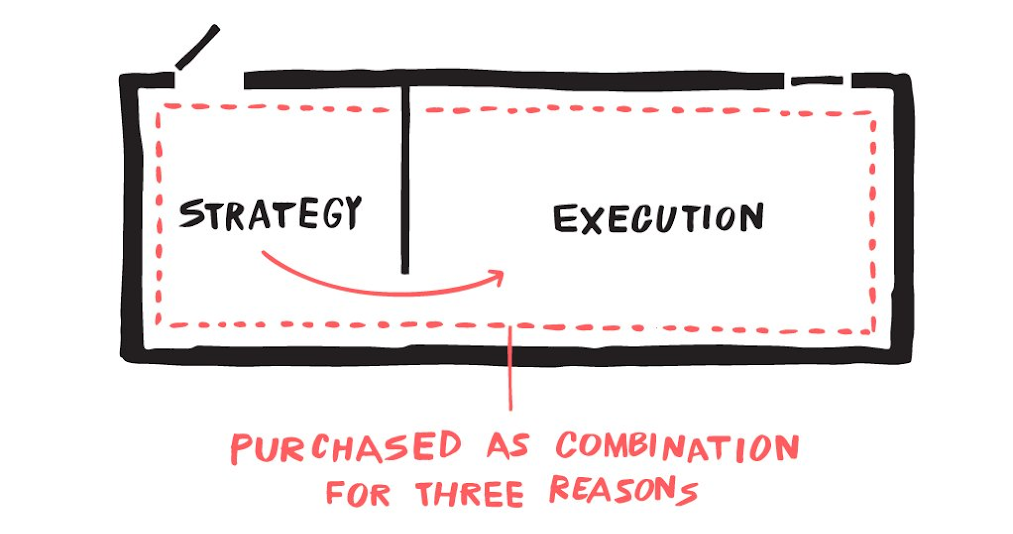The Strategic Independent: Book Outline
This piece is part of a book project to explore the theory and practice of independent consulting.
Chapter 1: The Strategic Independent
- The Strategic Independent (4,735 words)
- Narrative Institutions (in draft)
Chapter 2: Finding Work
- Small-b Blogging (1,539 words)
- Strange Attraction (3,004 words)
- Weak Ties & Strong Intros (3,468 words)
- Speak, Consultant (in draft)
Chapter 3: Bridging The Gap
- Workshops as Portals (2,766 words)
- The Anguish of Talking about Money (in draft)
Chapter 4: Effective Strategy Work
- High-Fidelity Consulting (stub)
- Strategy & Stewardship (stub)
- How to Get Things Done (stub)
- Strategy is the Organic Flow of Ideas & People (stub)
Chapter 5: Ways of Seeing
- The Consultant's Grain (2,583 words)
- Ways of Seeing (3,838 words)
- How (and why) to roll your own frameworks in consulting engagements (5,075 words)
Chapter 6: Yes! And...
- The Office is a Theatre of Work (2,768 words)
- Optimism as an Operating System (2,166 words)
- Blocking & Unblocking Clients (3,744 words)
- Navigating Power & Status in the Shadow Org Chart (4,207 words)
- The Contrary Consultant (4,090 words)
Chapter 7: Kairos Consulting
- Kairos consulting part 1 - The Consultant Out of Time (in draft)
- Kairos consulting part 2 - The Jigsaw of Independence (in draft)
Chapter 8: The Inner Life of Consultants
- I, Consultant (2,700 words)
- Compound Narrative (in draft)
The Strategic Independent
How to do better work for more money, whether you're a designer, writer or strategist.
In this post I want to break down what I mean by “strategic independent” and why, whatever path you’re on and expertise you have, you can bring more value for yourself and your clients by thinking strategically.
We’ll walk through:
- What strategic work is - by looking at a variety of contexts you might work within and how to spot them.
- Why strategic work is better - both for you and the client, offering more value to them and being more interesting for you.
- How strategic work enables you to charge more - and keep clients retained for longer, a compounding effect on your ability to charge more.
- How you can begin to think strategically - offering some real examples from my own career.
Finally, how being independent offers more value for your clients by enabling you to gain adjacent context that your client might not be able to see and that we get this adjacent from our network - and therefore we should really think of being codependent with our network.
Onwards…
Strategic work is work-in-context
Client work can be frustrating:
Ever had a project cancelled without notice?
Ever had to go through endless revisions and feel like you’re not getting it?
Ever had a project stall before it even started because you can’t agree on the exact deliverables?
Ever had a piece of work never get implemented by a client?
But frustration is a two player game - when you’re frustrated that work doesn’t make sense - the client is likely frustrated that your work doesn’t meet their objectives well enough.
Context is the key.
Even before I start working with a client in the very first meeting I always make sure I ask questions about business model, team structure, company priorities and more. These don’t always feel relevant to the specific request but help me better map out both the work I need to do and the stakeholders that need to see it.
The more you understand an organization the better you can understand context I wrote a whole post called ways of seeing that explores ideas around sensemaking inside an organization .
The more you understand an organization the better you can understand context1.
Overlapping contexts
So when I talk about strategic work - it’s about trying to understand the concentric circles of context at any time. For example - if you’re designing an app for a company the app might sit within a variety of business contexts This model seems… obvious? Except I’m always surprised at how often consultants and agencies fail to properly explore the wider contexts of the business either before starting work or during their engagement. :

However, in addition to the above context - that app design project might also exist within a variety of people contexts:

Every project exists in multiple overlapping contexts - here’s some of the types of context to look for:
- People (who are the stakeholders? what do they care about?)
- Resources (what can they realistically do with your work?)
- Brand (what is the position of the company?)
- Marketing (audiences, channels, analytics)
- Business model (revenue, profit)
- Product (how does their product work, what is possible?)
- The user (who is the user? What do they care about?)
Your work likely overlaps at least partly with all of these ideas - but also depending on your specific work you might have different contexts and add more nuance.
Strategic work is better work
Once you understand the concentric circles within which your work happens you’ll be able do work that’s more effective and useful for your clients.
Two examples from my own work:
Scenario #1
I was working as a marketing advisor for a client and early in the engagement (partly because we were discussing me becoming the full-time CMO) I was invited to sit in on their quarterly board meeting. This experience was formative in better understanding the drivers and motivations of the business - by understanding who literally owned the business better. This context was crucial for proposing work and for ensuring that pitching that work to the board was smooth. The CEO gave me some of the necessary context but by attending that board meeting I got a vantage point that I didn’t realize existed previously.
Scenario #2
Last year I was working with a client to integrate an acquisition into the main business - in particular to ensure that one business function was working correctly. My north star and most of the language in the team was about revenue projections for the function. Makes sense. But, I discovered that actually the SVP’s OKR for the quarter was ensuring that the business unit was functioning smoothly. While revenue was obviously a thing that they cared about, the more important context was around process and communication around that process. Once I had this context everything became easier since I could be more closely aligned with the objectives of the business.
Catastrophic Events & Context Collapse
There’s a certain kind of experience that I want to describe where everything goes to shit. Certain events in business collapse the environment. For example - let’s take that context model for app design from earlier in the post. But let’s assume that the growth objectives are “in crisis” - this could be missing targets, people change, overspend, change in marketing strategy etc
These catastrophic events collapse the environment and cascade downwards. Every circle inside gets ignored, paused, cancelled, changed, redefined. These events are felt like system-shock for anyone operating in these lower circles Not available for graphic design work. .

But for those above the fire-line there are two things that are crucial:
- Their objectives and priorities haven’t changed much, they’re still operating within the same context they were previously (although they may feel some turbulence)
- They likely knew about the catastrophic event ahead of time. They may even have been responsible for causing the catastrophic event.
We’ve likely all been personally inside a context as it collapses - either as a full time employee or a consultant / agency partner. It’s not fun.
Riding these crashes is a skill that I think in theory you can get good at - learning how to sprint at a moments notice in a new direction and operate supernaturally fast in a crashing environment.
But I think it’s way easier to instead always be searching upwards for more context awareness - i.e. working strategically. This helps you ride out those catastrophic events with more planning, awareness and foresight.
Strategic work is better paid
In addition to being better work (for clients and for you) - strategic work is also better paid.
As an independent - you’ll hear a lot of advice boil down to “charge more”. I’ve even said it myself! And it’s true - it’s the best advice you can get. Except… it’s kind of empty advice. I don’t think it provides much direction for how exactly you go about doing it.
Translating executional work into strategic work is a framework that I think gives concrete ways of continually ratcheting up the price & value of your work.
The key idea is that at every layer of context there are new kinds of work - and by reaching for associated layers of context you can get involved in new kinds of work that are associated with and grounded in the thing you know but also a slight stretch.
Not only can you charge more because the work is more useful, impactful and better but you can also charge for the associated parts of uncovering context - workshops, user research, competitive analysis, stakeholder interviews etc.
Let’s look at two examples:
Scenario #1 - From Writing to Strategic Writing
Let’s imagine you’re a writer - commissioned to write for a client’s branded content site. Let’s say you get paid $200 per article. The work: writing. How might we think of writing-in-context? Here’s a list of context that you should ask for and where it’s not available or it’s done poorly offer to step in:
- Creating a style guide for all the writers
- User research for end users to uncover what they want to read (e.g. by creating personas)
- Competitive analysis for other branded content sites, who writes for them and how they operate
- A content marketing plan for the branded content site
- A content marketing plan across the whole brand
- Themed content franchises that can scale beyond individual posts
- SEO research into keywords they care about targeting
Scenario #2 - From UX Research to Strategic Research
Let’s imagine you’re a UX researcher - creating user research from real users for clients. The work: creating user research projects, finding relevant users and running them. This is likely reasonably well-paid work as-is but let’s look at ways we might take this UX-research and place it in-context:
- Creating a set of product principles based off user research
- Reviewing a product roadmap
- Running a design sprint internally to ideate new product ideas (grounded in user research experience of course)
- Proposing a broader marketing focus group study
Some more examples of how work and associated context work might fit together:
- Work: email copywriter -> context: brand voice document
- Work: paid marketing -> context: paid marketing dashboard creation
- Work: marketing strategy -> context: hiring a marketing team
I’ve got a very loose working theory that every time you expand your context-circles you get paid an order of magnitude more money.
It’s not unreasonable to imagine:
- Writing: $200 / article
- Style guide: $2,000
- Content strategy: $20,000
These are necessarily imperfect analogies and will vary wildly from industry to industry I’m keen to hear more stories of different kinds of work where people have navigated this shift into wider contexts - email me! , but here’s a specific callout as you start to bundle “the work” and “the context”:
Don’t give the context work away for free. In fact, do the opposite - charge more for it than your regular work.
I see this often with more junior or less confident independents - you’re trying to close “the work” and so you throw in “the context” for free or as a sweetener.
Don’t do this! Work-in-context is typically more expensive than regular work so don’t be afraid to price it separately and confidently. Don’t worry if the client doesn’t bite at first - strategic work is only valuable at certain inflection points (see below graphs) but they’ll remember that you offered it and it’ll come back around.
Strategy and Stewardship - a framework for retaining clients for a long time
So we’ve established that you can get paid more money for strategic work - and now I want to show you that the new higher rates you’re charging can also last longer. A compounding effect on your pricing power.
I learned about the model of Strategy & Stewardship from the Helsinki Design Lab:
It is common these days for one group to be involved in analysis of a problem and designing the solution (consultants) while a different group executes these ideas (contractors). But this disconnects an essential feedback loop Page 40 of Recipes for Systemic Change by Helsinki Design Lab
Their solution? Strategy and stewardship:
We invoke stewardship in place of words like “implement” and “execute” out of recognition that the latter imply a cleanliness or linear progression which is rarely found when working on a shared proposition in a complex environment. Inside a factory plans can be executed, orders implemented, and outcomes delivered, but innovations that engage with the messy reality of the social sphere do not happen so neatly. What we describe also goes well beyond “facilitation,” which suggests that others do the important work. Stewardship shapes the course of innovation; it is not a neutral role. Think of stewardship as a form of leadership. One that acknowledges things will change along the way for better or for worse, therefore demanding agility over adherence to a predetermined plan. Many individuals who work in alliances or collaborative endeavors act as stewards almost naturally. If you are used to continually calibrating the goals of a project with the constraints of your context, you are practicing stewardship. If you maintain a constant state of opportunism and a willingness to pivot when progress on the current path is diminishing, you’re a natural steward Page 15 of Legible Practices by Helsinki Design Lab
This idea of a feedback loop between strategy and implementation is one I’ve taken to heart. It maps directly to my mental model of a typical long-term retained client relationship.
Imagine a 12-month client retainer with the strategic work in green and the implementation in blue:

You can see that (roughly) the total amount of work is constant but there is a phase shift from strategy at the beginning to mostly execution & implementation (stewardship) and then a hard shift back into strategic work.
If you look at strategy on its own:

There are two key things to draw from this chart:
The long-term work begins with strategic work, so if you want to get involved in a project early (a common request) you have to be thinking and working strategically.
But importantly, if you only do strategy work the client isn’t going to keep you around for months 3-12. No matter how lucrative that strategy work is, if you’re not shifting your outputs to implementation/stewardship then there isn’t enough work for either you or the client to justify sticking around and so you end up with a short sprint of a project.
Now, if you look at execution on it’s own:

There are two key drawbacks to only doing implementation/execution work:
Firstly - notice how the blue line shoots up a few months into the project? When you’re only working on the execution/implementation you get called into the project too late - the strategy is already set.
Secondly - notice how at some point in the future, the client either pauses, reviews or changes their strategy and the project unexpectedly ends? This can seem like it “comes out of nowhere” if you’re only doing the execution work and not aware of the wider context.
So what does stewardship work look like?
So what is stewardship exactly? Sometimes it’s literally just rolling up your sleeves to do the work outlined in the strategy. Never underestimate how powerful a single reference piece of work can be - e.g. you want the editorial team to produce 1000s of pieces of content over the next 12 months - but if you create the gold standard piece of content it can get referenced again and again and become the inspiration for a whole team.
So is the execution just plugging away in the trenches? Yes sometimes, but I think the most powerful stewardship work is around momentum - helping the organization or project accelerate their output. Some examples from my own work for things that look like stewardship:
- Hiring & building teams
- Building workstreams, processes
- Building dashboards and reporting templates
- Adding partnerships and relationships
If you take this strategy & stewardship approach - when the client comes to review the strategy at month 6 you’re still there working with the client and able to offer tangible and concrete insights into the work. How is the strategy evolving? Where should we adjust? What have we achieved?
Using this approach the average retainer length for clients I work with is 20 months.
I recall an important breakthrough for my own thinking - a client had hired another consultant to work on a project and afterwards I asked my client how the experience was and he said:
“It was fine - but he just gave advice. I like working with you because you’re not afraid to roll up your sleeves and do the work when it needs doing”
This was a real lightbulb moment for me - up until that time I’d always worried about doing “menial” or “low-paid” work as a consultant but charging a strategy-based day-rate.
But the thing I realized was that if you can provide momentum to an organization it doesn’t matter if you’re writing title tags in an SEO environment or putting together a board pitch you should do the most valuable thing the business needs at that moment.
The freedom of a consultant is that you can ignore job title / role / responsibility and be laser focused on moving the business towards key objectives and mixing your outputs from small to big as needed.
So, don’t undervalue either part of your work - either the strategy or the stewardship. Remember that graph up above with the blue/green strategy/execution mix? I bill it all at the same day rate. Stewardship is just as valuable as strategy and there’s no reason to somehow charge less for the execution work.
Only let clients in the strategy door
So we’ve established that the combination of strategy & stewardship is important - but there’s a crucial note to make:
Clients that come to you only for implementation are going to be your worst clients.
Wait what? Haven’t I been telling you to get your hands dirty? Yes, but…
In his book the business of expertise in chapter 10 titled “Distinguishing expertise from implementation” David Baker uses the great analogy of a building with two connected rooms and two entrances, one for strategy and one for execution.
The whole chapter is a delight and the punchline is: “only let clients in the strategy door”:

The argument really boils down to:
- Implementation work is hard work to sell - you get poor quality clients expecting a more easily commoditized output that drives your business towards lower margins
- Not only that but implementation work is often more stressful and deadline-driven
- So of course do both for clients but only let them in through the strategy door to ensure that you do better, higher value and higher margin work.
You should really buy the book - it’s a fast read but has lots of pieces of wisdom There is however a shorter (older) version of this argument from David online here .
Importantly - if you accept that you can do a lot of implementation work for clients but they should all start with strategy then your external positioning should be entirely focused around the strategy work to attract the right kinds of clients.
Time & Money
Here’s a funny thing - when you read the accepted literature about pricing as an independent you’ll hear again and again that pricing based on time is a bad thing To be fair - many of the freelancer advice posts do caveat their advice saying day-rates are ok, but it’s ually a footnote and I think it’s easy to come away as a beginner only understanding that charging for time is bad. I know I did. . And, maybe they’re right - but I’ve had plenty of success charging on a loosely-coupled time-based approach (almost all of my work is scoped at a day rate, at least to begin with).
I have a theory that this time-based approach to pricing is especially powerful as you move through a context-transition.
Why? Well - as you go through this cycle of exposure to new contexts and working in new contexts you are by definition operating in new types of work and new types of environments and it’s hard to control the inputs and outputs.
Put simply - as you ladder up into wider contexts for your work you don’t yet have enough experience to properly scope and price the work - not to mention you may be continually expanding your context not upwards but sideways into new types of workstreams.
So I say - if you’re reading the commonly accepted wisdom about pricing and feeling like you’re doing it wrong by pricing based on time let me tell you that you’re totally fine and that strategic work by definition can be fuzzy and so scoping on project work can be dangerous.
My own journey out of SEO
Looking back at my career - this idea of doing work-in-context has determined the path I’ve taken from SEO manager to digital strategy to consulting work.
The problem with SEO is that it’s inherently non-strategic. As an activity it’s increasingly commoditized and marginalized. Not that SEO-traffic is not important or that SEO is going away, but that the strategic activities you undertake to achieve business-level goals are usually not owned by SEO practitioners or agencies Yes, there are exceptions to this of course but there’s a reason there’s no widely recognized c-suite SEO function. .
This wasn’t always true - there was a golden age of ~2008-2012 where an SEO agency could get directly in front of the CMO to work on digital strategy. Back in 2011 when I worked at Distilled it wasn’t uncommon to be working directly on digital strategy for fortune-500 brands, in a context model that looked something like this:

But I could see the writing on the wall and could feel the shift as everyone else in digital “caught up” to the competencies and experience that the SEO industry had built up over the previous decade to the point where a more traditional SEO engagement now looks like this:

As I felt this shift towards SEO being less strategic I needed to find ways to expand my context and work in different types of work more directly and explicitly.
When I first started consulting in 2014, yes I worked mostly on SEO projects. But I was keenly aware of the wider context and pushed myself to ask questions and be curious - whether about the business model or the teams executing the work.
Over time - by asking questions and pushing for more context I was able to start to get involved in several different wider context-circles and evolve the work I do One consequence of this of course has been a difficulty in describing the work I do. For more thoughts on describing and defining my work see my post on media design. .
How to learn to be more strategic
Taking my personal SEO example above it’s hard to overstate the importance and value of being curious. Being curious about the industry you’re in and how it works, being curious about the clients you’re working for and being curious about the context of your own work is where this whole strategic independent path starts.
Then, from there the path to strategic work looks something like this:
- Ask questions and be curious (about the business, the industry, the people)
- Explicitly ask to see surrounding context (e.g. as a writer, ask for the content strategy, as a marketer ask for the strategic roadmap)
- Then, next time explicitly ask to be included in the creation of the surrounding context
- Then, start offering and leading the projects to add the surrounding context
- Repeat as you expand your context
Here’s a worked example from my own experience on “how to be more strategic” as I learned about brand positioning work for clients:
- The first step was being curious about brand positioning - how does it work? What does it look like? I got exposed to a handful of these kinds of projects at Google and always asked questions
- The second step is to keep your ear close to the ground and ask to be involved in a brand positioning workshop or project as it’s happening - just as an observer / participant.
- The third step is to spot opportunities for where a brand positioning project would make sense and add value and source a partner to help with the work for a client - where I’m leading and owning the work output but working with a partner.
- The fourth step is creating and running a brand positioning project on my own for a client (probably smaller to begin with while I gain confidence).
This explicit evolution and experience in my own work probably took 3-4 years with the help of some friends but is exactly that ladder of context-awareness that enables you to get involved in strategic work.
As you can see, this path to strategic work relies on gaining context from client work - but there’s another way to gain context - from your network.
The adjacent-context benefit of independence
Most of this post focuses on the idea of context as gathered from your client and their business - but there’s another great source of context: peers.
Co-dependence is really the right word for independence Frank was kind enough to point out that in-fact co-dependence is not the right word at all! The actual definition of the word is around enabling addiction. I didn’t know that! The correct word is interdependence and Frank Chimero has a more recent post all about this topic: back to the cave. Thanks Frank! . I’ve talked a lot about the power of the network - both as a tool for gathering leads for your business but also as an emotional support network.
Frank Chimero wrote a wonderful essay I think about often titled the inferno of independence which is hard to boil down but looks at the nature of independent work - and articulates this shift from independence to co-dependence:
Listen: we only deserve what we can maintain and keep safe. A community is only as good as how well it takes care of all its members. There is no independence. There is only subservience or co-dependence. And I choose you. I choose community.
Co-dependence and network building has plenty of other benefits I wrote about using a network to build a steady stream of high value leads in my post strange attraction. but one key benefit of a diverse network is the adjacent-context. Some of the most helpful context you bring to your clients as an independent is the context they would otherwise not have access to or overlook.
Adjacent context is thinking laterally about an industry, organization or problem - looking sideways for unusual or unexpected analogies or insights into expanding contexts that might not be obvious to you or your clients. You can only get this from hanging around a blend of interesting people who are also context-aware.
So then, the strategic independent is someone who not only helps bridge context inside an organization but outside as well. This distance from a client’s organization is extremely valuable - and yet another reason not to undersell the value of context before and during an engagement. Someone able to connect the dots and do work-in-context but also expand the context into new directions.
Will you join me on the path to being a strategic independent?
Hopefully this long post was helpful - let’s recap the main points:
- Work-in-context is more rewarding & more effective for you and the client
- It also allows you to charge for additional types of work! Hence making you better paid
- But it also allows you to work with clients over a long time-horizon, extending the length of your client contracts (a compounding effect on revenue when combined with charging more)
- As you begin to shift to strategic work - start to only let clients “in the strategy door” - you’ll get better clients this way
- Learning how to be strategic is relatively straight forward (even if it takes a while) by constantly looking for additional context
- And, as you work in fluid context-shifting client work don’t be afraid to charge based on time - despite what the received wisdom advises.
- Finally as an independent remember that co-dependence with your network is actually the ideal state and you can gain context from peers just as much as you can from clients
I’m writing a book. Originally it was designed for “independent consultants” and… that’s still an audience. But I realized writing this post that the audience is wider - I’m writing not just for those doing “consulting” or even “strategy work” but also designers, writers, researchers, leaders who are doing strategic work, independently - the strategic independent.
To peek the outline for the book head over here, and you can subscribe to my newsletter here to keep updated with the latest.
I’d love to hear your experience with strategic work, independence and context. Leave me some comments below!
–
Thank you to the amazing people who reviewed early drafts of this piece, commented and generally made this piece better including: Adam Wiggins, Chris Butler, Rachel Joy Victor, John Doherty, Mark Pollard, Josh Braaten & Brian Dell.
–
Update: April 26th 2019 I spent an hour discussing the ideas in this post with Jonathan Stark from the podcast Ditching Hourly and you can listen to that episode here.
-
I wrote a whole post called ways of seeing that explores ideas around sensemaking inside an organization ↩
Thanks for reading. This post is part of my book project The Strategic Independent: Theory & Practice for Independent Consultants.
Join the email list to get updates on new posts (~ monthly emails)